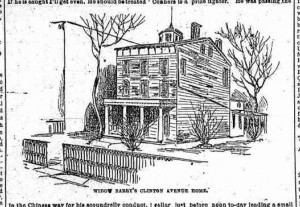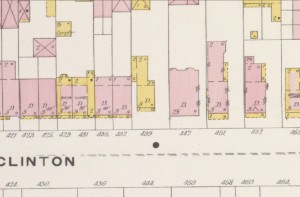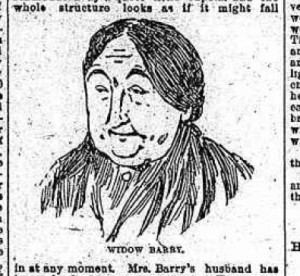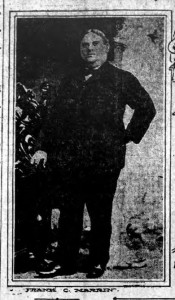A CURE FOR WEALTH ON CLINTON AVE (1895)

Brownstone Detectives investigates the history of our clients’ homes.
The story you are about to read was composed from research conducted in the course of one of those investigations.
Do you know the history of YOUR house?
********************************************************************************************************************************

Along an avenue shaded with tall oaks and plane trees once sat the home of a rich old recluse who’d been swindled of nearly all of her life’s savings in her declining years.
A “tumble down” and “badly dilapidated old three story frame house,” the structure “stood forlornly upon the lot at 439 Clinton Avenue in Fort Greene,” noted the Brooklyn Daily Eagle.
The roof of the house was “surmounted by a queer little cupola, and the whole structure looks as if it might fall in at any moment.”
In short, the Eagle sardonically noted, the house looked as if the owner, Mrs. Caroline Barry, had lived in it ever since the death of her husband “without either painting it or repairing it in any way.”

The Eagle was likely going a bit over the top with regards to the house’s condition, as it seemed much out of place situated between stately structures of brick and brownstone all along Clinton Avenue.
But as the house has been gone for more than 100 years now, it is impossible to know what its actual state was for certain.
What we do know, though, is what it looked like from a drawing done by the newspaper and from Sanborn Fire Insurance maps. From the former, we see a mid-19th century classical wood frame house. From the latter we know that the house was, indeed, a wood-frame structure, and that by 1904 it had come down and was replaced with a modern brick 3-story building with bay windows on the front and sides.
Also, to give an idea of the social prominence of the neighborhood, and why the neighbors may have been dismissive of her, Mrs. Barry also lived adjacent to Brooklyn Mayor Charles Adolph Schieren.
SNAKE OIL FORTUNE

But back to Mrs. Barry, because at the time the poor woman had been bilked out of much of her dead husband’s snake oil fortune.
That husband, Mr. Alexander C. Barry, “a Scotchman who came to this country long years ago,” noted the Eagle, “invented a hair restorer, which coined him a large amount of money and gave him a great reputation a generation or two ago.”
Known as “Barry’s Tricopherous” or “Professor Barry’s Tricopherous,” the oil promised to “restore the hair to bald heads,” and to “make it grow thick, long, and soft.”
We all know how well that likely worked.
Mrs. Barry, observed to be over 60 years of age and, according to the Eagle (which took great license in regards to style), was “a very eccentric woman, so her neighbors declare.
“She dresses in a peculiar manner to suit herself, though no one else could approve of the style.”
No one, that is, on Clinton Avenue.
SWINDLED, MRS. BARRY WANTS HIS HEAD

Regardless, though, of Mrs. Barry’s style of dress or peculiarities of habit, she had been “swindled out of between $30,000 and $50,000” by her attorney and investor, Frank C. Marrin.
As Mrs. Barry colorfully tells it, “Mrs. Marrin, Marrin’s mother, came to see me. We were friendly when she was 16. She came to see me and her son thought there was business in it for him and he came too. He was plausible and polite and in 1891 I gave him some money to invest. He did business for me every year from then. Even last year he invested money for me. Oh, I know now what he was after.”
What Marrin was “after” was her life’s savings and that was exactly what he got. Promising to invest her money for her, he did just the opposite – he invested her money in his very own opulent lifestyle. In return, he paid Mrs. Barry some of the interest he made on her money and little else – other than an armful of “bogus mortgages on which he had forged the certificates of registry purporting to have been made by the Register of this county.”
“He only wanted to get all he could get out of me,” Mrs. Barry complained. “He never invested any for me. He paid me interest out of what I gave him and kept the rest.
“He should be treated in the Chinese way for his scoundrelly conduct. When they cheat like that in China they are beheaded.”
HOW THE END CAME FOR THE SWINDLER

Frank C. Marrin, once arrested in 1895, posted bail and, subsequently, fled Brooklyn. Years later, in 1908, after sightings on and off around the country, he was finally identified living the high life in Philadelphia under the assumed name “Judge Franklin Stone.” There, and in many other cities, he had conducted swindles similar to the one he performed in Brooklyn.
Amongst them was the one that brought him down – the Storey Cotton Company speculation – which he operated out of Chicago. In it, Marrin “obtained thousands of customers by mail all over the country” by promising “that he could so accurately foretell the rise and fall in the price of the great Southern staple that none could lose who invested with him.”
That sort of promise, though, like Prof. Barry’s cure for baldness, was only to be given for so long before, in the end, the believers of each assurance were left without money. Or hair.
POSTSCRIPT
Marrin was found guilty of a number of crimes and served ten years in prison. After his release, he was still making promises. Now, however, a reformed man, he was declaring his intent to help those convicts unfairly placed behind bars.
By 1920, though, he was a practicing real estate lawyer. No mention of pro bono assistance for convicts is on record anywhere.
Mrs. Barry, however, died before seeing Marrin come to justice. Living in penury when she passed at 87, she was still at her home at 439 Clinton Avenue.
“She had everything wrapped up in paper ready for removal,” the Eagle noted. “She expected that some day Marrin would be found and that she could recover her money and again live in the style to which she was accustomed.
“We found paper even around the bird cages.”
———————————————————————————————————————–
 Brownstone Detectives is an historic property research agency. Our mission is to document and save the histories of our clients’ homes. From our research, we produce our celebrated House History Books and House History Reports. Contact us today to begin discovering the history of your home.
Brownstone Detectives is an historic property research agency. Our mission is to document and save the histories of our clients’ homes. From our research, we produce our celebrated House History Books and House History Reports. Contact us today to begin discovering the history of your home.